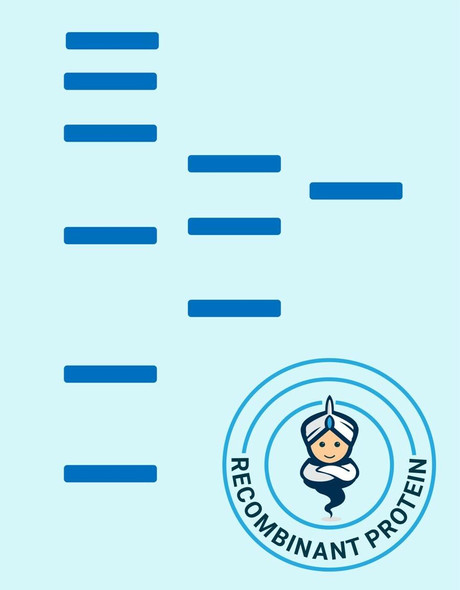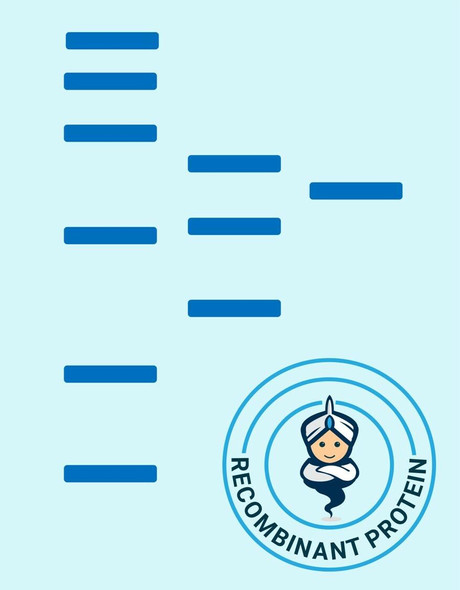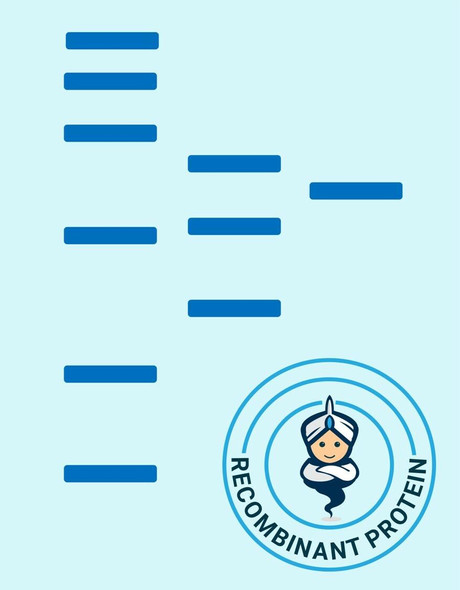Human GLP 2 Recombinant Protein (RPPB1322)
- SKU:
- RPPB1322
- Product type:
- Recombinant Protein
- Size:
- 5mg
- Species:
- Human
- Target:
- GLP 2
- Synonyms:
- GLP2
- GLP-2
- GLP 2
- Uniprot:
- P01275
Description
| Product Name: | Human GLP 2 Recombinant Protein |
| Product Code: | RPPB1322 |
| Size: | 5mg |
| Species: | Human |
| Target: | GLP 2 |
| Synonyms: | GLP2, GLP-2, GLP 2. |
| Physical Appearance: | Sterile Filtered White lyophilized (freeze-dried) powder. |
| Formulation: | The protein (1mg/ml) was lyophilized with no additives. |
| Solubility: | It is recommended to reconstitute the lyophilized GLP-2 in sterile 18M?-cm H2O not less than 100 µg/ml, which can then be further diluted to other aqueous solutions. |
| Stability: | Lyophilized GLP2 although stable at room temperature for 3 weeks, should be stored desiccated below -18°C. Upon reconstitution GLP2 should be stored at 4°C between 2-7 days and for future use below -18°C.For long term storage it is recommended to add a carrier protein (0.1% HSA or BSA).Please prevent freeze-thaw cycles. |
| Purity: | Greater than 95.0% as determined by RP-HPLC. |
| Amino Acid Sequence: | His-Ala-Asp-Gly-Ser-Phe-Ser-Asp-Glu-Met-Asn-Thr-Ile-Leu-Asp-Asn-Leu-Ala-Ala-Arg-Asp-Phe-Ile-Asn-Trp-Leu-Ile-Gln-Thr-Lys-Ile-Thr-Asp-Arg |
GLP-2 functions as an intestinal growth factor, which stimulates intestinal epithelial growth. GLP2 is involved in diabetes-associated bowel growth. GLP2 enhances cell differentiation, playing a role as a cytokine and in tissue regeneration, and mediating cytoprotection. GLP2 is invloded numerous therapeutic applications. GLP2 regulates signaling pathways coupled to cell proliferation and cell death by apoptosis.GLP-2 is produced by specific post-translational proteolytic cleavage of proGLP. GLP-2 is manufactured by the intestinal endocrine L cell and by several neurons in the central nervous system.
GLP-2 contains 34 amino acids having a molecular mass of 3922.38 Dalton.
| UniProt Protein Function: | GCG: Glucagon plays a key role in glucose metabolism and homeostasis. Regulates blood glucose by increasing gluconeogenesis and decreasing glycolysis. A counterregulatory hormone of insulin, raises plasma glucose levels in response to insulin-induced hypoglycemia. Plays an important role in initiating and maintaining hyperglycemic conditions in diabetes. Glucagon release is stimulated by hypoglycemia and inhibited by hyperglycemia, insulin, and somatostatin. GLP-1 and GLP-2 are induced in response to nutrient ingestion. Glucagon is secreted in the A cells of the islets of Langerhans. GLP-1, GLP-2, oxyntomodulin and glicentin are secreted from enteroendocrine cells throughout the gastrointestinal tract. GLP1 and GLP2 are also secreted in selected neurons in the brain. Belongs to the glucagon family. |
| UniProt Protein Details: | Protein type:Secreted, signal peptide; Secreted; Hormone Chromosomal Location of Human Ortholog: 2q36-q37 Cellular Component: extracellular space; endoplasmic reticulum lumen; extracellular region; plasma membrane Molecular Function:identical protein binding; protein binding; hormone activity; glucagon receptor binding; receptor binding Biological Process: positive regulation of protein binding; positive regulation of histone H3-K4 methylation; signal transduction; positive regulation of peptidyl-serine phosphorylation; G-protein signaling, coupled to cAMP nucleotide second messenger; response to starvation; G-protein coupled receptor protein signaling pathway; cell proliferation; cellular protein metabolic process; positive regulation of protein kinase activity; positive regulation of cAMP biosynthetic process; energy reserve metabolic process; feeding behavior; regulation of insulin secretion; negative regulation of apoptosis |
| NCBI Summary: | The protein encoded by this gene is actually a preproprotein that is cleaved into four distinct mature peptides. One of these, glucagon, is a pancreatic hormone that counteracts the glucose-lowering action of insulin by stimulating glycogenolysis and gluconeogenesis. Glucagon is a ligand for a specific G-protein linked receptor whose signalling pathway controls cell proliferation. Two of the other peptides are secreted from gut endocrine cells and promote nutrient absorption through distinct mechanisms. Finally, the fourth peptide is similar to glicentin, an active enteroglucagon. [provided by RefSeq, Jul 2008] |
| UniProt Code: | P01275 |
| NCBI GenInfo Identifier: | 125987831 |
| NCBI Gene ID: | 2641 |
| NCBI Accession: | P01275.3 |
| UniProt Secondary Accession: | P01275,Q53TP6, A6NN65, |
| UniProt Related Accession: | P01275 |
| Molecular Weight: | 20,909 Da |
| NCBI Full Name: | Glucagon |
| NCBI Synonym Full Names: | glucagon |
| NCBI Official Symbol: | GCG |
| NCBI Official Synonym Symbols: | GLP1; GLP2; GRPP |
| NCBI Protein Information: | glucagon; preproglucagon; glucagon-like peptide 1; glucagon-like peptide 2; glicentin-related polypeptide |
| UniProt Protein Name: | Glucagon |
| UniProt Synonym Protein Names: | Incretin hormone |
| Protein Family: | Glucagon |
| UniProt Gene Name: | GCG |
| UniProt Entry Name: | GLUC_HUMAN |










